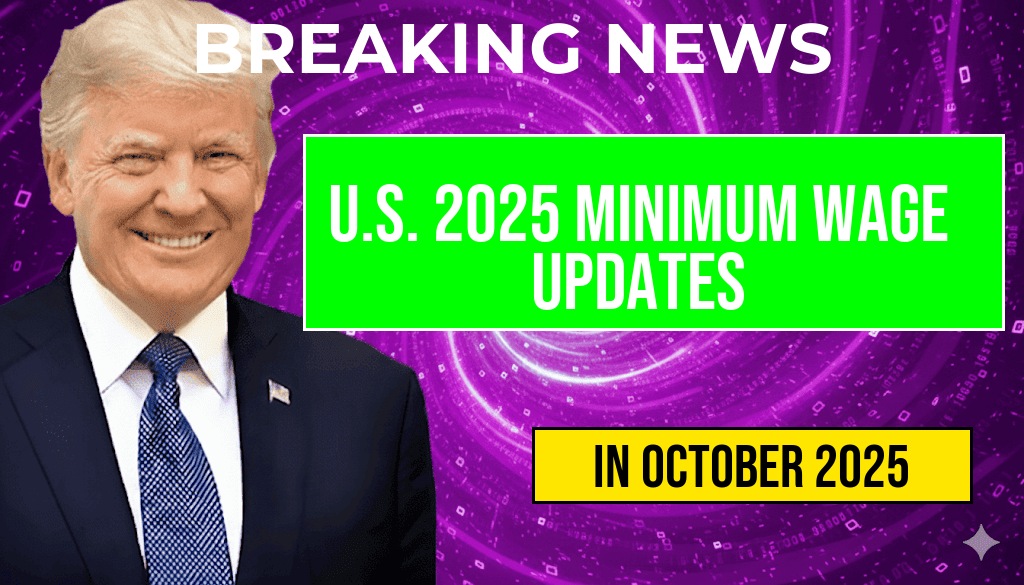The United States is set to implement new minimum wage rates for 2025, effective October 4, marking a significant update in the nation’s labor standards. These adjustments come after a series of state and local government decisions to increase wages, reflecting ongoing efforts to address economic disparities and improve living standards for low-wage workers. The updates will vary depending on jurisdiction, with some states adopting higher rates aligned with inflation and cost-of-living increases, while others maintain federally mandated minimums. This shift is expected to influence millions of workers across various industries, from retail to hospitality, and shape future wage policies nationwide.
State and Local Wage Adjustments for 2025
Federal Minimum Wage and Variations
The federal minimum wage remains at $7.25 per hour, a rate established in 2009. However, numerous states and cities have set their own minimum wages higher than the federal level, often tied to annual inflation adjustments or local economic conditions. The upcoming changes for 2025 will see many jurisdictions updating their rates, some reaching as high as $15 per hour or more.
Major State Updates
| State | 2024 Rate | 2025 Rate | Notes |
|---|---|---|---|
| California | $15.50 | $16.00 | Incremental increase aligned with inflation |
| New York | $15.00 | $15.75 | Phased increase in New York City and surrounding counties |
| Florida | $11.00 | $11.50 | Statewide minimum wage adjusted annually |
| Texas | $7.25 | $7.25 | Federal minimum still applies in most areas |
| Washington | $15.74 | $16.28 | Annual inflation adjustment |
Local Minimum Wage Trends
Several cities are leading the way in establishing higher minimum wages, often surpassing state standards. For instance, Seattle and San Francisco are set to increase their minimum wages to over $17 per hour in 2025, reflecting local economic conditions and policy priorities aimed at reducing income inequality. These local decisions often serve as models for neighboring jurisdictions considering similar measures.
Factors Influencing Wage Adjustments
Inflation and Cost of Living
Many wage increases are driven by inflation rates, which have fluctuated significantly in recent years. Governments frequently link minimum wage adjustments to inflation indices such as the Consumer Price Index (CPI), ensuring wages keep pace with rising living expenses. This approach aims to prevent workers from experiencing diminished purchasing power over time.
Legislative and Political Dynamics
Wage policies are also shaped by legislative debates and political priorities. Progressive lawmakers advocate for higher minimum wages as a means to promote economic equity, while opponents often cite concerns about potential impacts on employment and business costs. The 2025 updates reflect ongoing negotiations and balancing acts within state legislatures and city councils.
Impacts on Employers and Workers
Business Considerations
- Increased labor costs may lead some employers to adjust staffing levels or automation strategies.
- Small businesses could face challenges balancing wage hikes with profitability, prompting calls for phased implementation or targeted support programs.
- Large corporations generally have more resources to absorb wage increases, potentially passing costs onto consumers.
Worker Benefits and Economic Effects
- Higher wages are expected to enhance household incomes, reducing reliance on social safety nets.
- Increased earnings could boost consumer spending, stimulating local economies.
- Workers in low-wage sectors may experience improved job satisfaction and financial stability.
Additional Resources and Outlook
For a comprehensive overview of minimum wage policies across the U.S., visit Wikipedia’s Minimum Wage Law page. Industry analysts predict that wage adjustments will continue to evolve, influenced by economic conditions, political will, and societal demands for fair compensation. As the 2025 updates roll out, stakeholders remain attentive to the broader implications for employment, business competitiveness, and income distribution.
Frequently Asked Questions
What are the updated minimum wage rates for 2025 in the U.S.?
The minimum wage rates for 2025 will vary by state and locality, with many regions implementing increases effective October 4. Employers and employees should check their specific area for the exact rates.
When do the new minimum wage rates take effect?
The updated minimum wages become effective starting October 4, 2024, ensuring workers are compensated at the new rates throughout 2025.
Which regions are increasing their minimum wages for 2025?
Numerous states and cities across the U.S. are implementing minimum wage hikes for 2025. To find specific rates, check local government announcements or official websites for your area.
How do minimum wage increases impact employers and employees?
The minimum wage increases aim to improve workers’ earnings and reduce wage inequality. Employers may need to adjust their payroll budgets, while employees benefit from higher income levels starting October 4.
Are there any exceptions or special rules related to the 2025 minimum wage hikes?
Some regions may have exceptions such as lower minimum wages for certain age groups or types of employment. It is important to consult local regulations to understand specific rules and exemptions.

Leave a Reply